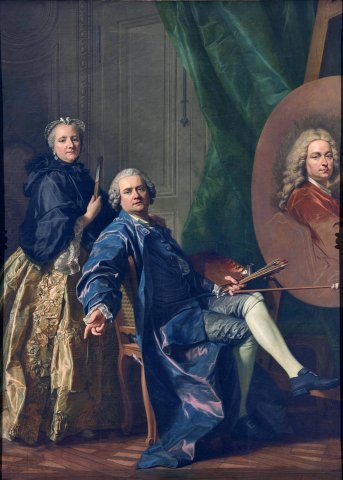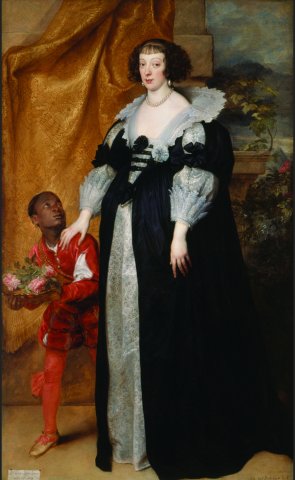[p.350]
Louis-Michel Vanloo
This painter was attached to the Spanish court1. I don't know why he's no longer there, but he's certainly a great artist.
The Portrait of the author, accompanied by his sister and working on his father's portrait, is a beautiful thing2.

The painter occupies the middle of the canvas. He is seated. His legs are crossed and one arm is crossed over the back of his armchair. He is resting. The sketch of his father's portrait is in front of him on an easel. His sister stands [p.351]behind his armchair. Nothing could be simpler, more natural or truer than this last figure. The artist's robe does silk wonderfully. The arm hanging over the back of the armchair is completely out of the canvas; all you have to do is pick it up. The family air could not be better preserved in the three heads. In all, the piece is amply done3 and deserves the highest praise; the heads are noble and greatly touched4.
With all this, you might ask, how does this compare with Van Dyck for truth, with Rembrandt for strength?

But while there are so many different ways of writing, each of which has its own particular merit, could there be only one way of painting well [?] Because Homer is more impetuous than Virgil, Virgil wiser and more numerous than the Tasso, the Tasso more interesting and more varied than Voltaire, shall I refuse my just tribute to the latter5? Moderns envious of your contemporaries, how long will you continue to belittle them with your eternal comparisons with the Ancients? Is it not a very strange way of judging to look at the Ancients only from their beautiful points of view, as you do, and to close your eyes to their faults, and on the contrary to have your eyes open only to the faults of the Moderns and to keep them stubbornly closed to their beauties [...] To praise the authors of your pleasures, will you always wait until they are no more? What's the use of praise they can't hear?
I'm always annoyed that among the superstitions with which men have been stubborn, it has never occurred to us to persuade them that they would hear under the grave the evil or the good that we would say about them. [p.352]
I'm just as angry that these pieces of paint, which have the freshness and brilliance of flowers, are doomed to fade as quickly as they do.
This disadvantage stems from a way of doing things that doubles the effect of the painting for the moment. When the painter has almost completed his work, he freezes it. To glaze is to pass over the whole a light layer of the color and hue appropriate to each part. This layer, light in color and heavy in oil, has the function and defect of a varnish; the oil dries and yellows as it dries, and the painting smokes6 more or less, depending on whether it has been painted more or less frankly.
A painter is said to paint with full colors or frankly, when his colors are more unes, less tormented, less mixed7.
It is conceivable that oil spread on places where there are many different colors mixed and melted causes an action of one on the other and a decomposition from which yellow, gray, black spots are born, and the general harmony is lost.
The places that will suffer most are those where there will be ceruse8 and other metallic limes that the fatty substance will revive.
A sculptor a little jealous of the duration of a work that costs him so much trouble, should always support the delicate and fragile parts of it on solid parts; and the painter prepare and grind his colors himself, and exclude from his palette all those that can react on each other, decompose, revivify, or suffer, like salts, by the acid of the air. This acid is so powerful that it tarnishes even porcelain paints.
The art of giving paint long-lasting colors is almost [p.353] yet to be found. It seems that most limes, all saline substances, should be banished, and only pure, well-washed earths admitted.
It is a strange thing the diversity of judgments of the multitude that gathers in a Salon. After wandering there to see, one should also take a few turns there to hear.
People of the world cast a disdainful and distracted glance at the great compositions, and are arrested only by the portraits whose originals they have present.
The man of letters does just the opposite. Passing quickly by the portraits, the large compositions fix all his attention.
The people look at everything and agree on nothing9.
It's when they meet on the way out that they're pleasant to hear. One says: Have you seen the Marriage of the Virgin10? It's a beautiful piece! ... No. But what about the Portrait de la comtesse11? that's what's so delicious... Me, I just don't know if your countess has been painted. I'd have fun with a portrait, whereas I have neither too many eyes nor too much time for Deshays' Joseph12 or Greuze's Paralytic13.... Ah, yes; it's that man next to the stairs who's about to be given extreme unction... This is how nothing passes without praise and blame: he who aims for general approval is a fool. Greuze, why must an impertinence afflict you? There's always a crowd around your painting, and I have to wait my turn to approach it. Can't you hear the voices of surprise and admiration coming from all sides? Don't you know you've done something sublime? What more do you need than your own suffrage and ours?
As long as portrait painters will make me nothing but likenesses, [p.354] without composition14, I will say little about them; but when they have once felt that to interest requires action, then they will have all the talent of the history painter, and they will please me regardless of the merit of likeness.
A singular dispute has arisen here between artists and people of the world. The latter claimed that the main merit of a portrait was to resemble; the artists, that it was to be well drawn and well painted. What does it matter to us," said the latter, "whether the Van Dycks look like or not? Are they any less masterpieces in our eyes? The merit of resemblance is fleeting; it's the merit of the brush15 that amazes in the moment, and eternalizes the work. It's a sweet thing for us," they replied, "to find on canvas the true image of our fathers, our mothers, our children, those who have been the benefactors of mankind and whom we miss. What was the first origin of painting and sculpture? It was a young girl who used a piece of charcoal to follow the contours of her lover's head, whose shadow was cast on a lit wall16. Between two portraits, one of Henri IV poorly painted, but resembling, and the other of a faquin17 of concussion18 or of a silly author painted to miracle, which one will you choose? Who is it that fixes your eyes on a bust of Marcus Aurelius or Trajan, Seneca or Cicero? Is it the merit of the artist's chisel or the admiration of the man?
From which I conclude with you that a portrait must be resembling for me, and well painted for posterity.
What is certain is that nothing is rarer than a fine brush, more common than a dauber who makes one look like, and that when the man is no more, we assume likeness19.
Yes, but the attraction of truth is so invincible that it would be enough for the most beautiful portrait by Van Dyck to have retained the reputation of not having resembled, to lose its price. This is because the first merit of a portrait is to resemble, whatever one may say, and a great painter only has to make fantasy heads20, if he doesn't have the talent to give resemblance.
Notes
By 1736, Louis-Michel Vanloo had become the official painter to the court of Philippe V of Spain, in Madrid. In 1752, he helped found the Royal Academy of Fine Arts in San Fernando, under the patronage of King Ferdinand VI, who had succeeded Philip V in 1746. Ferdinand wished to remain neutral in the conflict that was brewing between France and England (the Seven Years' War): it's not impossible that Spain's cooling towards France motivated Vanloo's return to France in 1753.
See #000781.
"To paint largely is to give large brushstrokes and distribute objects over large masses" (Dom Pernéty, Dictionnaire portatif de peinture, Paris, Bauche, 1757, art. Large, p. 388)
" To touch, is still said in several kinds of arts. It is said that a man touches the organ, lute, theorbo delicately; to say, that he plays them fort bien: that a Painter has well touched a line of his painting. Pulsare. This Painter touches well a tree, a landscape; to say, that he succeeds very well in painting them. It is likewise said, that a Poet has well touched a passion, such a character; to say, that he has made vivid & natural expressions of them." (Trévoux) In the context of Salons, to touch means to paint, and connotes the manner of painting in a positive, sensitive way.
5 In a letter to Sophie Volland dated August 12, 1762, Diderot wrote of Voltaire: "This man is only second in all genres." (CFL V 712)
Noircit.
"Franchise de pinceau, etc, se dit de la facilité, de la liberté et hardiesse de la main de l'artiste, dans un travail qui, quoique négligé en apparence, caractérise l'habileté et le génie savant de celui qui apparaît l'avoir fait sans gêne, en badinant." (Pernéty, op. cit., p. 327)
" Ceruse, s. f. Lead white. Cerussa. This is what the Chemists call it." (Trévoux, who specifies that ceruse is used by women for blush, despite the harmful nature of the product)
Diderot writes here in the spirit of Horace: Odi profanum vulgus, et arceo (Odes, III, 1, 1), I hate the vulgar people and keep my distance. Later and elsewhere, for example in the Preamble to the Salon of 1763, he insists instead on the importance of public judgment, which develops taste and raises the level of competition between artists.
The Marriage of the Blessed Virgin by Deshays. See #000748.
The Portrait of the Countess of Egmont Pignatelli in Spanish costume, by Roslin. See #000729.
See #009632.
See #001058.
The article *Composition de l'Encyclopédie (1753) is Diderot's first major theoretical contribution on painting. At the time, Diderot was still relying on the theses of Shaftesbury, who above all evaluated the work of art on the basis of the coherence of the arrangement of its figures: its organization.
The merit of the brush is the technical virtuosity of the painter, regardless of the likeness.
The first painting is said to have been done by the daughter of Dibutade, a potter from Corinth, who ironed the outlines of her lover's shadow on the wall, to preserve a trace of it after his departure. (Pliny, Natural History, book XXXV, §152)
" Faquin, masc. subst. Crook, man of the dregs of the people, vile & contemptible." (Trévoux)
" Concussionnaire, adj. m. Judge, Officer, or Public Receiver, who demands greater rights, greater sums than those which are duës, or taxed." (Trévoux)
Resemblance therefore no longer matters: we always assume, after the fact, that a portrait is resembling.
Heads, or fantasy figures, are imaginary portraits. Fragonard composed a series of them: some figures have been identified (Mlle Guimard, #018242; Jérôme de Lalande, #018243), others remain conjectural (Naigeon, #018245), one figure was identified as a portrait of Diderot, then the identification was abandoned (#006251).
Les Salons de Diderot (édition)
Archive mise à jour depuis 2023
Les Salons de Diderot (édition)
Salon de 1763
Préambule du Salon de 1763
Louis-Michel Vanloo (Salon de 1763)
Deshays (Salon de 1763)
Greuze (Salon de 1763)
Sculptures et gravures (Falconet, Salon de 1763)
Salon de 1765
La Chaste Suzanne (Carle Vanloo, Salon de 1765)
Boucher (Salon de 1765)
La Justice de Trajan (Hallé, Salon de 1765)
Chardin (Salon de 1765)
La jeune fille qui pleure son oiseau mort (Greuze, Salon de 1765)
La Descente de Guillaume le Conquérant en Angleterre (Lépicié, Salon de 1765)
L'antre de Platon (Fragonard, Salon de 1765)
Sculpture (Salon de 1765)

